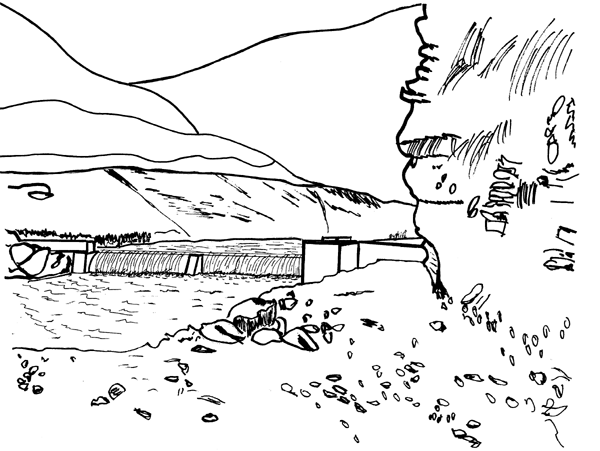

The dam was a concrete spill-over, located two miles up the canyon of Deadhorse Creek. It created a reservoir, as opposed to any kind of hydro-electric facility. On the south side, there was an old tin shack boiler room, which defied my imagination as to what it ever did. The creek always dried up, in the peak of summer, while the reservoir continued to hold water. Presumably, the water supplied the steam plant, for heating, versus being a source of drinking water. It also supplied the fire hydrants.
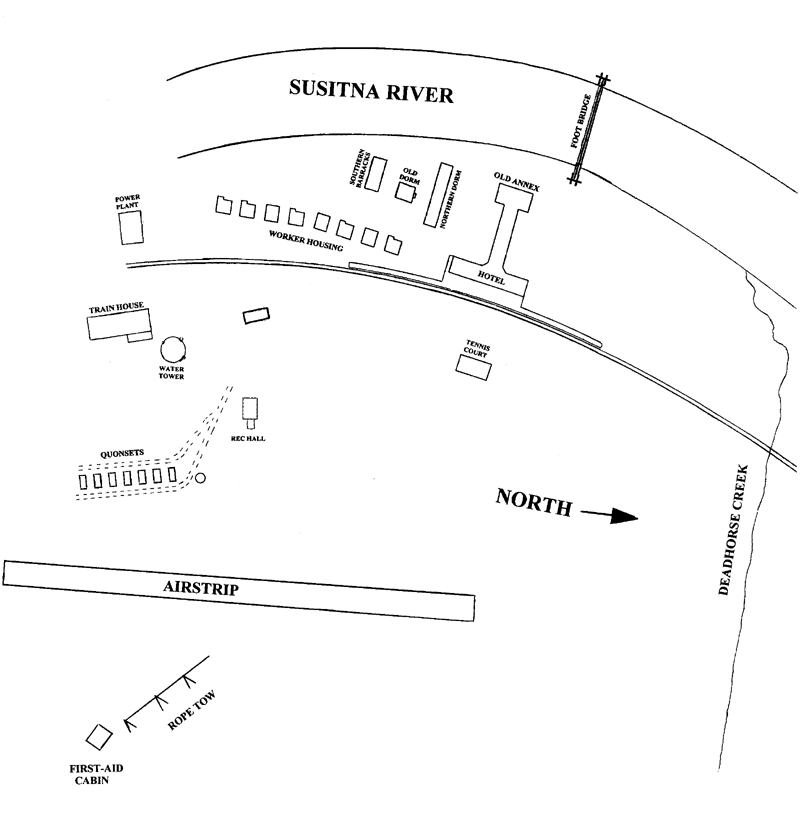
The Northbound train would usually arrive in the morning, the southbound train at night. The schedules would change with the season. Curry was far enough out, that broadcast radio reception was minimal, requiring the typical extended aerial wire, for any reception, at all.
The ACS would get in one movie a day; which became the main evening attraction for all. The leather chairs in the lobby would be arranged to form a crude theater.
On Friday's there would be an evening BINGO game.
There was a small airstrip, maybe 2,000 feet long. On the northeast side, there was a green-painted crude nose-in warm-up "hangar;" big enough to stick a small aircraft nose into, for warming it up. The 'door' was a canvas flap. Beside that was one of the engines for the ski-slope tow rope.
On the east side of the airstrip, there was the ski slope, featuring a broken down rope-tow. The birch pole tripod stands and pulleys were there, but the rope was rotting on the ground. Up on the hill was a log cabin, known as the "First Aid cabin. The name derived from the presence of a 5-gallon can of bandages, with a circular pop-top and a red dross on its side. Just below the cabin was an engine-shack, for the upper end of the ski tow-rope. Below the cabin, facing west, was a crude ski-jump.
To the north side of the hotel was a small pond, which appeared to have been man-made. It contained a buried pipe, as though it was once used as a water source. It was a suitable swimming pond, about fifty feet across; and twenty feet deep (providing me with my first experience at nearly drowning). The pond was surrounded by sand and silt, from the regular spring flooding of the Susitna river; add a population of willows.
Curry had a couple of railroad side-lines for parking everything from old "troop train" cars to construction crew cars. An old steam locomotive and an obsolete snowplow car were 'stored' there. There was also a "Y," for turning train cars around, located at the southern end of Curry. In that vicinity was the "Dynamite Shack," a sturdy corrugated tin building. Just north of the hotel, there was a fallen-down suspension footbridge, crossing the Susitna river. By 1955, the bridge was nothing less than dangerous. For children going near that bridge, it was worth a severe spanking – ask me! I swear the whole town was watching that one! Scare or angry, Dad took it out on my behind (My sister, Karen, did it too!)
I can only recall one of the ACS guys crossing the bridge, in the fashion of Indiana Jones – by 1955, it was that fallen-down. Yes, he had an audience.
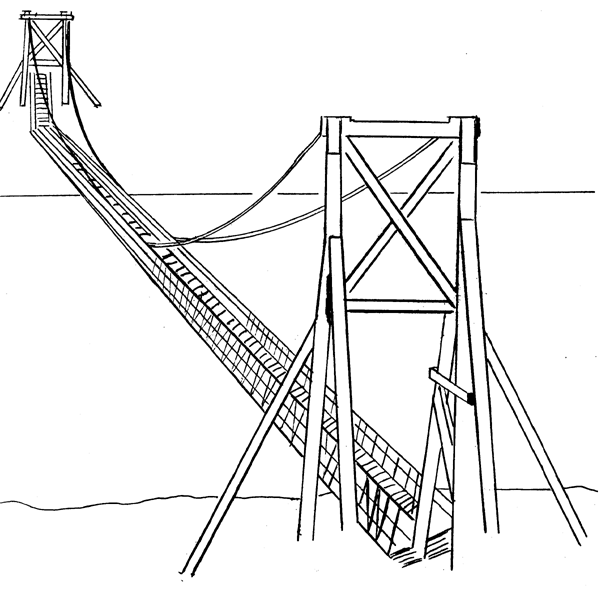
If I remember correctly, the only thing the bridge served was a distant hexagonal "lookout;" great for panoramic pictures – including Mt. McKinley.
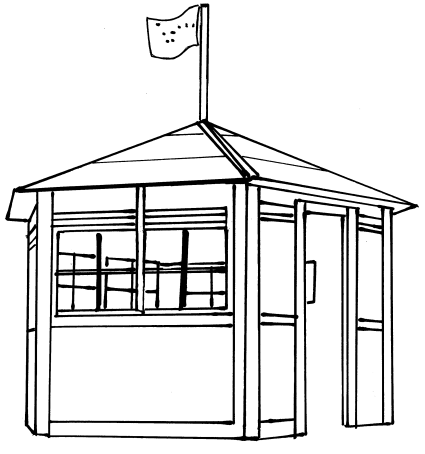
THE LOOKOUT
However, it was about a five-mile walk, to the lookout - once you got across the bridge and up the first hill.
To the immediate south of the hotel, there were three barracks buildings, of different size; with a row of eight houses immediately west of the railroad tracks, provided for the permanent railroad workers. Those had coal-burning kitchen stoves.
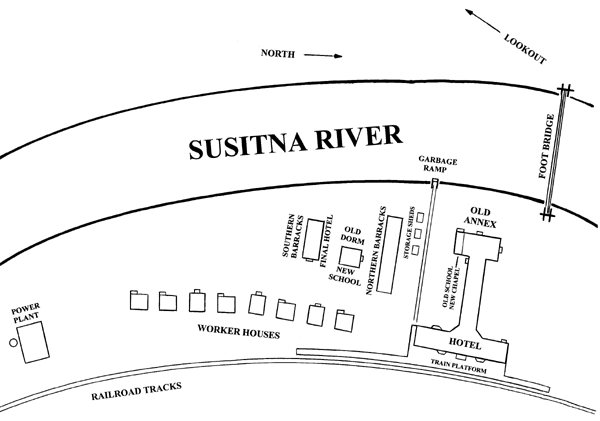
CURRY'S
WEST SIDE
On the east side of the tracks, there was a log cabin – around 20' by 30' - which was a recreation clubhouse; consisting of a main room, with a conventional wood construction extension in the back, with some storage rooms; also leading to a set of smelly out-houses. I seem to remember that it was once used as a dance hall and a BINGO hall. After the hotel burned, it was occasionally used as a chapel, by Reverend Urban. I think it was once used for a school Christmas play. I remember the cold steel folding chairs. By all appearances, the rec hall and "First-Aid Cabin" were close copies of each other. The rec hall had smaller windows, though.
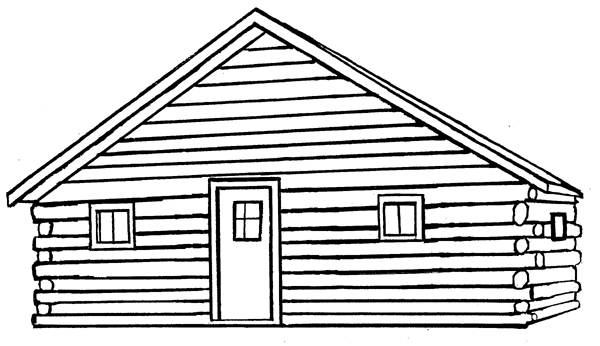
REC HALL
There was also a cement-slab tennis court, located directly across from the hotel. Adjacent to that, to the southeast, there was a small clearing, occasionally used as a baseball field. I can remember one 4th of July softball game, instigated by Carol Yakasoff; boy, could she hit a soft-ball!